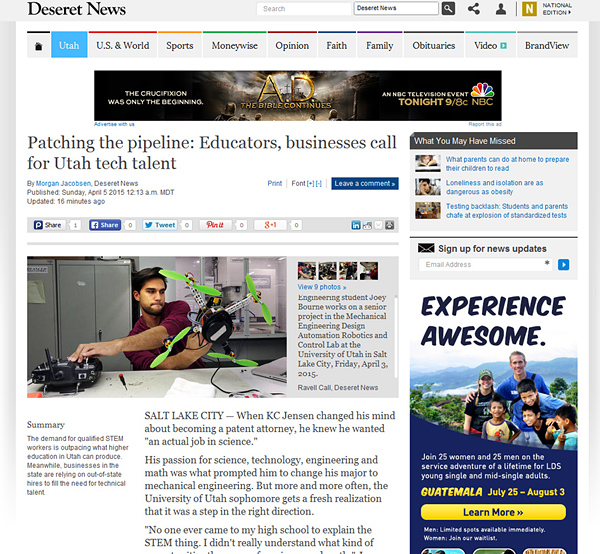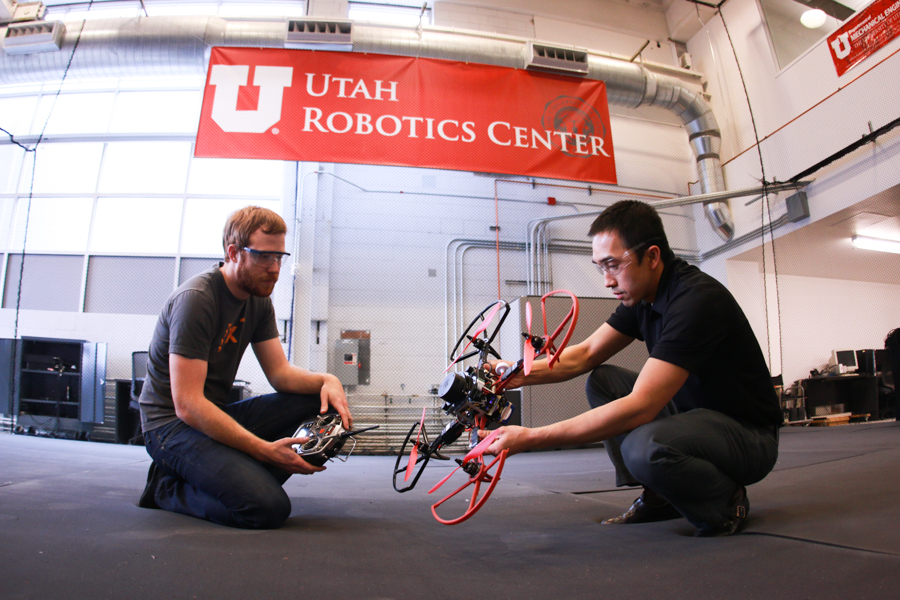Utah Robotics welcomes Dr. Tucker Hermans as Assistant Professor in the School of Computing. Dr. Hermans received his Ph.D. degree in Robotics from Georgia Tech’s School of Interactive Computing in 2014. He worked under the supervision of Aaron Bobick and Jim Rehg in the Computational Perception Laboratory. Shortly before joining the University of Utah, Dr. Hermans was a postdoctoral researcher in the Intelligent Autonomous Systems lab at Technische Universitӓt Darmstadt in Darmstadt, Germany. There, he worked with Jan Peters on tactile manipulation and robot learning, while serving as the team leader at TUDa for the European Commission project TACMAN....
Read MorePhotos of robotics students featured in Deseret News article
Photos of robotics students working the DARC Lab featured in a Deseret News article on Sunday, April 4, 2015. Link to the full article:http://www.deseretnews.com/article/865625733/Patching-the-pipeline-Educators-businesses-call-for-Utah-tech-talent.html ...
Read MoreProf. Abbott receives NSF Collaborative Research: Shepherding Biomedical Microswimmers Using Magnetic Fields
Jake Abbott (PI) receives NSF grant entitled, “Collaborative Research: Shepherding Biomedical Microswimmers Using Magnetic Fields”. Total budget: $230,427, duration: 8/15/2014-8/14/2017. This project is in collaboration with Henry Fu at the University of Nevada, Reno....
Read MoreProf. Leang receives DOE STTR Phase I grant for high-speed AFM
Prof. Leang and industry partner Molecular Vista, Inc., San Jose, CA, recently received Dept. of Energy STTR Phase 1 grant, “Video-rate atomic force microscope for functional gas and liquid environments”. In this 9-month project, the team plans to develop a prototype video-rate AFM system for investigating materials in gas and liquid environments. The $150,000 project will allow the team to show proof of concept with the hope of pursuing a Phase II grant to continue the work....
Read MoreProf. Meek receives NSF NRI grant: Biologically-inspired, hybrid quadruped robot control
This research project is about designing better legs for legged robots. When a robot needs to move across rough terrain, as would be the case when searching for victims in a disaster area, legged robots have advantages over wheeled or tracked robots. They can traverse such terrain more easily, for example, stepping over fallen beams and bricks. However, legged robots are inherently more complex. They have many more joints and are more difficult to control. The goal of the project is to use ideas from nature to overcome some of these difficulties. The shape and compliance of four-legged animals...
Read MoreProf. Abbott receives NIH grant entitled, “Magnetic Guidance for Improved Cochlear-Implant Insertion”
Jake Abbott (PI), in collaboration with researchers at the University of Utah and Vanderbilt University, was awarded a National Institutes of Health (NIDCD) grant “Magnetic Guidance for Improved Cochlear-Implant Insertion.” $1,842,850. 8/1/2014-7/31/2019....
Read MoreNSF — CHS: Small: Toward a New Generation of Untethered Magnetic Haptic Interfaces
Dr. Jake Abbott (PI) and David Johnson (co-PI) receive National Science Foundation grant, project entitled, “CHS: Small: Toward a New Generation of Untethered Magnetic Haptic Interfaces “. The three-year project has a budget of $500,000, duration 8/1/2014-7/31/2017....
Read MoreProf. Leang receives NSF grant to work with UAVs
Project title: PFI:BIC — Enhanced Situational Awareness Using Unmanned Autonomous Systems for Disaster Remediation, $800,000 (9/15/2014 – 9/14/2017) Team: PI: Kam K. Leang; Co-PIs: W. Yim (UNLV), G. Bebis, C. Murray, and G. Kent (UNR). Industry partners: Drone America and SpecTIR The goal of this project is to enhance the situational awareness capabilities of law enforcement agencies and first responders by employing unmanned autonomous systems (UAS) with high-resolution sensing and imaging capabilities for disaster remediation. Law enforcement agencies and first responders face significant challenges during an emergency event, such as a natural or anthropogenic disaster (earthquake, tsunami, fire, hurricane,...
Read MoreProf. Leang receives NSF grant: COLLABORATIVE RESEARCH: HIGH-SPEED AFM IMAGING OF DYNAMICS ON BIOPOLYMERS THROUGH NON-RASTER SCANNING
Prof. Leang and collaborators at the Boston University receive $697,835 NSF grant: COLLABORATIVE RESEARCH: HIGH-SPEED AFM IMAGING OF DYNAMICS ON BIOPOLYMERS THROUGH NON-RASTER SCANNING. The primary aim of this project is to create a novel high-speed atomic force microscope (AFM) imaging system with frame rates of on the order of 100 frames/second. While the creation of this instrument may have a significant impact on a broad range of application areas, the primary target is the study of biomolecular processes. The extremely fast frame rate and long range will allow for the direct visualization of dynamic process that previously could...
Read More





